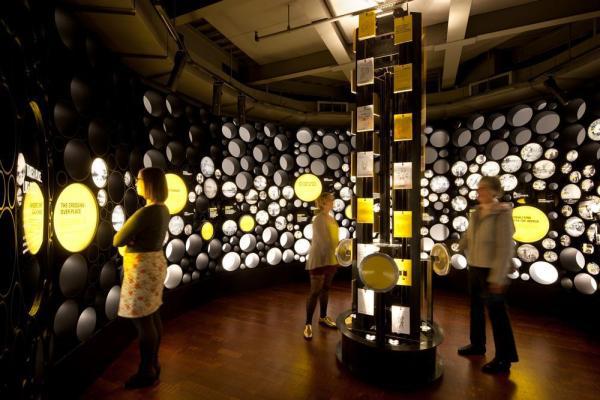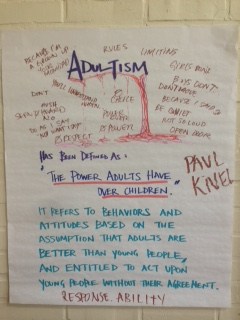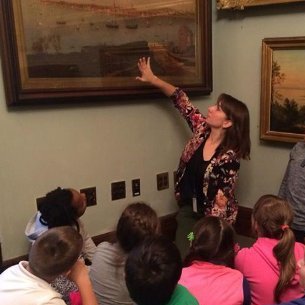
Adultism is “the everyday, systematic, and institutionalized oppression that young people face at the hands of adults” (Kivel). Denial of political power. Lack of privacy. Physical and emotional abuse. Arbitrary punishments. Rules they did not create. You’re so smart for your age. Do as I say, not as I do. It’s just a phase. At its heart, adultism tells young people and children that they are not as important as adults or are not taken seriously, and makes them feel powerless and inadequate. In considering the work that we do with young people in the name of social justice, it’s important to remember that adultism is the means by which young people learn to accept inequality as truth. It is through the stripping of their agency and habitual disregard for their opinions and desires that they learn to accept the exploitation and violence that maintain hierarchies of wealth and power.

As museum-based educators we’re in a great position to provide experiences and environments that offer a respite from this oppression. At their best, our programs center student voice and celebrate the knowledge they bring with them. We get to be the good guys: the people who let them have fun, express themselves, and construct their own meaning. So often, however, we reflect on student-centered learning as a pedagogical method and less as a tool for liberation. It’s important to take a step back and reflect on where our teaching lies within the context of perpetuating and/or combatting adultism. Are we offering adult-youth relationships that challenge the status quo? Are we providing young people with the tools to craft their own reality? How can we break down adultism at an institutional level?I was introduced to the term at a workshop on youth voice co-facilitated by Creative Advantage and the Seattle Art Museum earlier this year. Although the literature on and use of adultism as a framework is limited, it makes sense why so many local youth organizations have adopted it. Work to combat adultism already exists under another name: youth empowerment. But unlike “ageism” or “youth empowerment,” using the term “adultism” explicitly names and calls attention to adult privilege and power. It draws connections across the different ways that youth are mistreated or denied power, and allows space to consider the ways age interacts with the privileges or oppression handed to youth because of their race, gender, class, ability, sexuality, and more.
This past year I’ve thought a lot about what I can do as an adult to either hand over some of my power, make more room for young people in our institution, or teach youth how to recognize and combat adultism on their own. As a result, the following three goals have been posted above my desk:
Relinquish control
How can I provide young people as much control as possible in a safe and supportive way? Where can I let them influence the direction of a program? In supervising our youth advisory board as they plan an event, my job is simply to help them figure out how to turn their ideas into reality. With school groups I frame instructions as asks, suggestions, agreements, and I always explain my why behind non-negotiables.
Teach and model consent
Always ask their permission before you do something in their personal bubble. Let them know you prefer high fives instead of hugs. Expectations apply to everyone, including adults. Practice challenge by choice and let them know “no” is always an option. Act as a mediator between youth and other adults who wish to benefit from their presence without offering anything in return.
Create space for youth voice outside direct programming
How can we achieve youth empowerment on an institutional level? If you have a youth advisory board or other young people with whom you are in regular contact – do they serve as a resource to colleagues outside your department? When other staff or board members are assembling an advisory committee, do they include young people? Make a visible commitment to youth voice and choice, and speak up for them in places they are absent or unable to participate.
Lastly, I’d like to emphasize that this framework is applicable to our work with those over the age of 17, for youth extends beyond our legal definitions of child and adulthood. College students, interns, and emerging museum professionals are all impacted by attitudes that the young or inexperienced are less valuable and inferior. Particularly for those who are new or hesitant to pushing for internal change at your museum, I encourage you to frame your practice in youth empowerment as a practice in combatting oppression. Perhaps then it will seem easier to apply those same skills that you already have from being a youth advocate to new situations and challenges.
Sources: Kivel, Paul. Getting Together for Social Justice, Winter 2009. http://paulkivel.com/wp-content/uploads/2015/07/getting_together_2009.pdf
Emily Turner is the K-12 Youth Programs Educator at the Museum of History & Industry (Seattle) where she designs and facilitates learning experiences for students and families, manages the MOHAI Youth Advisors program, and supervises interns. Twitter @emkturn






